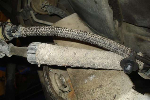dpom
Member
- Joined
- April 7, 2003
- Messages
- 18
- Reaction score
- 0
- City, State
- Winthrop, MA
- Year, Model & Trim Level
- 94 XLT
I am doing my first AC repair on my 94 XLT. I hooked up the gauges and there was no pressure in the system. I attempted to pull a vacuum and the gauge only went to about 19 in Hg. After closing the thumb valve the pressure stayed there for 10 minutes. I wasn't totally convince the vacuum pump is working the way it should, so I hooked the pump directly to the gauges and it pulled to 19 in Hg.
The pump works off of my air compressor at 75 psi, it should pull 29.9 in Hg. Is there something wrong with this pump? I don't hear any hissing. Should I buy/rent an electric one?
Thanks, Dave
The pump works off of my air compressor at 75 psi, it should pull 29.9 in Hg. Is there something wrong with this pump? I don't hear any hissing. Should I buy/rent an electric one?
Thanks, Dave










